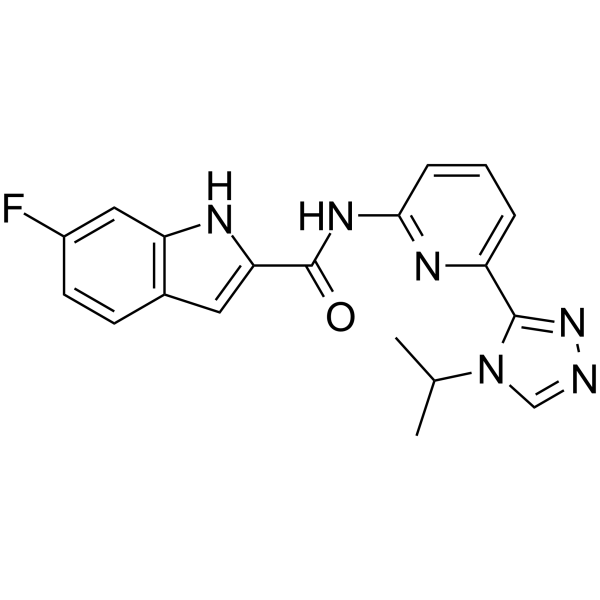Physicochemical Properties
| Molecular Formula | C19H17FN6O |
| Molecular Weight | 364.3763 |
| Exact Mass | 364.144 |
| CAS # | 2541792-70-3 |
| PubChem CID | 155671000 |
| Appearance | White to off-white solid powder |
| LogP | 2.5 |
| Hydrogen Bond Donor Count | 2 |
| Hydrogen Bond Acceptor Count | 5 |
| Rotatable Bond Count | 4 |
| Heavy Atom Count | 27 |
| Complexity | 534 |
| Defined Atom Stereocenter Count | 0 |
| SMILES | FC1C([H])=C([H])C2C([H])=C(C(N([H])C3=C([H])C([H])=C([H])C(C4=NN=C([H])N4C([H])(C([H])([H])[H])C([H])([H])[H])=N3)=O)N([H])C=2C=1[H] |
| InChi Key | LYUQNMNUBOUCBX-UHFFFAOYSA-N |
| InChi Code | InChI=1S/C19H17FN6O/c1-11(2)26-10-21-25-18(26)14-4-3-5-17(23-14)24-19(27)16-8-12-6-7-13(20)9-15(12)22-16/h3-11,22H,1-2H3,(H,23,24,27) |
| Chemical Name | 6-fluoro-N-[6-(4-propan-2-yl-1,2,4-triazol-3-yl)pyridin-2-yl]-1H-indole-2-carboxamide |
| HS Tariff Code | 2934.99.9001 |
| Storage |
Powder-20°C 3 years 4°C 2 years In solvent -80°C 6 months -20°C 1 month |
| Shipping Condition | Room temperature (This product is stable at ambient temperature for a few days during ordinary shipping and time spent in Customs) |
Biological Activity
| Targets | ASK1 32.8 nM (IC50) |
| ln Vitro | In AP1-HEK293 cells, ASK1-IN-2 (compound 19) (10 mM; 1 h) reduces luciferase reporter activity with a 95.59% suppression rate[1]. |
| ln Vivo | In mice, dextran sulphate sodium (DSS)-induced ulcerative colitis (UC) is ameliorated by ASK1-IN-2 (25 mg/kg; po daily for 7 d)[1]. In mouse colon tissues treated with DSS, ASK1-IN-2 (25 mg/kg; po daily for 7 days) inhibits the ASK1-p38/JNK signaling pathways and lowers inflammatory cytokine levels[1]. In rats, ASK1-IN-2 (1 mg/kg; iv) has a moderate half-life (T1/2=1.45 h) and poor clearance (CL=1.38 L/h/kg[1]. Rats treated with ASK1-IN-2 (10 mg/kg; po) exhibit high oral exposure (AUClast=4517 h·ng/mL), 62.2% oral bioavailability, and a tolerable terminal half-life (T1/2=2.31 h)[1]. |
| Animal Protocol |
Animal/Disease Models: Male ICR mice (18 -22 g, 6-8 weeks) were given 3% DSS (w/v) orally in drinking water[1] Doses: 25 mg/kg Route of Administration: Po daily for 7 days Experimental Results: Induced a significant recovery of body weight loss, with an increase of +11.2%. diminished the disease activity index (DAI) score about a 2 unit. Dramatically prevented colon shortening. Attenuated a severe colonic tissue damage and infiltration of inflammatory cells. Animal/Disease Models: Male SD rats [1] Doses: 1 mg/kg for iv; 10 mg/kg for po (pharmacokinetic/PK Analysis) Route of Administration: Iv and po administration Experimental Results: Iv: CL=1.38 L/h/kg; T1/2=1.45 h. Po: AUClast=4517 h• ng/mL; F=62.2%; T1/2=2.31 h. |
| References |
[1]. Structure-based discovery of 1H-indole-2-carboxamide derivatives as potent ASK1 inhibitors for potential treatment of ulcerative colitis. Eur J Med Chem. 2020 Dec 24;211:113114. |
Solubility Data
| Solubility (In Vitro) | DMSO : 250 mg/mL (686.10 mM) |
| Solubility (In Vivo) |
Solubility in Formulation 1: ≥ 2.08 mg/mL (5.71 mM) (saturation unknown) in 10% DMSO + 40% PEG300 + 5% Tween80 + 45% Saline (add these co-solvents sequentially from left to right, and one by one), clear solution. For example, if 1 mL of working solution is to be prepared, you can add 100 μL of 20.8 mg/mL clear DMSO stock solution to 400 μL PEG300 and mix evenly; then add 50 μL Tween-80 to the above solution and mix evenly; then add 450 μL normal saline to adjust the volume to 1 mL. Preparation of saline: Dissolve 0.9 g of sodium chloride in 100 mL ddH₂ O to obtain a clear solution. Solubility in Formulation 2: ≥ 2.08 mg/mL (5.71 mM) (saturation unknown) in 10% DMSO + 90% Corn Oil (add these co-solvents sequentially from left to right, and one by one), clear solution. For example, if 1 mL of working solution is to be prepared, you can add 100 μL of 20.8 mg/mL clear DMSO stock solution to 900 μL of corn oil and mix evenly. (Please use freshly prepared in vivo formulations for optimal results.) |
| Preparing Stock Solutions | 1 mg | 5 mg | 10 mg | |
| 1 mM | 2.7444 mL | 13.7219 mL | 27.4439 mL | |
| 5 mM | 0.5489 mL | 2.7444 mL | 5.4888 mL | |
| 10 mM | 0.2744 mL | 1.3722 mL | 2.7444 mL |
